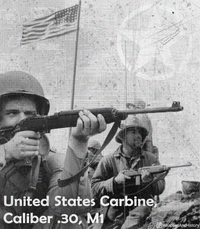U.S. Carbine, Caliber .30 M1
The M1 carbine, or the U.S. Carbine, Caliber .30, M1, is an American made semi-automatic Carbine chambered in .30 carbine. It is the most produced rifle from WW2
- History
The M1 Carbine was designed from 1938-1941 as a request from the U.S. Army ordnance department for a new lightweight, short and small caliber for support troops/non infantry troops. Instead of using the .30-06 from the M1 garand rifle and .45 acp from the M1A1/M3 submachineguns, the ordnance department wanted a new rifle cartridge bridging the gap between .30-06 and .45. Winchester developed the .30 for the carbine program
After some rifle designs not pasting the test, Winchester engineers came up with the idea to scale down their M2 rifle design to .30SL, it was made within 2 weeks using alot of scrap parts from other rifles, and this rifle made through the trials and was adoptes in 1941 was the M1 carbine
From 1941-1945, there were a total of +6.100.000 M1's produced, but not only by Winchester. The M1 was also produced by General motors, IBM, Underwood typewriter company and many others.
- Mechanism
The M1 uses a short stroke gas piston under the barrel, and a rotating bolt similair to the M1 Garand.
The M1 feeds from either 15 or 30 round magazines, and it has no last round hold open (it can be locked manually)
The rifle has 2 aperture sights for 150and 300 yards.
- Variants
M1: Original fullstock carbine for non-infantry troops
M1A1: Side folding stock variant for paratroopers
M2: Select fire variant, saw usage in the end of WW2
M3: M2 with infra red night vision optic
- Usage
The M1 was widely used in WW2 by the allied powers, after WW2 it was used during the Korean war, Vietnamese war (M2 was the standard issued rifle to south Vietnamese forces) and almost every war you can imagine after it.
The U.S. retired the rifle in 1973, but continued in service by other nations
